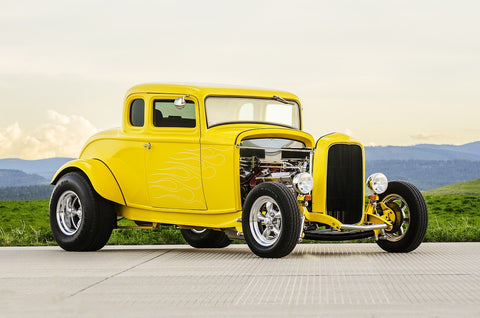Hot rods are some of the most iconic custom cars in automotive history. These highly modified vehicles have a rich history stretching back to the early 20th century. In this article, we'll explore the origins of hot rods, how they evolved over the decades, the culture surrounding them, and why they remain so popular today.
Origins of Hot Rods: Souped Up Model T's in 1930s California

Hot rods trace their origins to Southern California in the 1930s. There, young gearheads tinkered with old Ford Model T and Model A coupes and roadsters, modifying them extensively for improved performance. These early hot rodders strived to make their cars lighter, lower, and faster.
Stripping unnecessary parts helped reduce weight. Lowering the suspension improved handling and aesthetics. And upgrading the engine, exhaust, and carburetion squeezed out more horsepower. Due to their limited budgets, early hot rodders had to be creative and resourceful.
The term "hot rod" itself first appeared in the late 1930s. Some stories say it originally described the souped up Ford V8s running bootleg liquor during Prohibition. Other tales credit Southern California car clubs like the Road Runners for coining it. In any case, "hot rod" captured the speed and excitement these modified cars generated.
Post-War Boom: Car Clubs, Print Magazines, and More Advanced Mods
After World War II ended, hot rodding exploded in popularity across America. GIs returning home had mechanical skills and a taste for excitement. Car clubs allowed hot rodders to share tricks and show off builds. Los Angeles native Wally Parks founded the National Hot Rod Association (NHRA) in 1951 to promote safety and sanction drag races.
Magazines also accelerated the hot rod craze. Titles like Hot Rod and Car Craft spread the culture nationwide and offered how-to advice. Artists like Ed "Big Daddy" Roth introduced wild custom paint jobs and airbrushed monsters like Rat Fink. Gear ratios, carburetors, and other modifying techniques grew more advanced.
The iconic 1932 Ford "Deuce" model became a favorite for building hot rods due to its lightweight frame and abundant aftermarket parts. Many rodders came to favor the "3-window" coupé body style. However, roadsters, sedans, pickups, and even panel vans also got modified.

Roaring into the Mainstream: Drag Racing and the Rise of Muscle Cars
Hot rodding roared into the mainstream during the 1950s and 1960s thanks in large part to organized drag racing. NHRA's nationwide drag strip network gave hot rods a place for legal competition. Magazines and movies like American Graffiti (1973) portrayed the rebellious, car-crazy teen culture.
Detroit auto companies took notice. Seeing hot rods' appeal with younger buyers, they launched muscle cars like the Pontiac GTO, Plymouth Road Runner, and Ford Mustang. This combined factory hot rodding with salesroom reliability. Pony cars evolved into another youth-oriented sensation.
However, the 1973 oil crisis and emissions regulations slowed automotive excitement. Detroit shifted focus to fuel efficiency as hot rod culture eased. But a vibrant grassroots scene kept the old spirit alive.
Hot Rod Revival: DIY Cars, Car Shows, and Pop Culture Spotlight
By the 1990s, hot rodding was on the rise again. Hand-built hot rods from shops like Boyd Coddington combined old-school style with modern equipment. Print magazines pivoted to websites and forums to reach new generations.
Large events like the SEMA Show and the Grand National Roadster Show gave hot rodders a place to gather and show off rides. Classic car insurance helped collectors drive their rods more often. Media coverage and reality TV shows like Overhaulin' shined a new spotlight.
Today hot rod culture remains strong, appealing especially to Baby Boomers seeking to recapture their youth. Contemporary rods run the gamut from nostalgic period-correct builds to wild customs with ECU-controlled fuel injection and high-tech disc brakes. But the DIY ethos and quest for speed still drive this iconic automotive hobby.
From humble homemade beginnings nearly a century ago, hot rods have become an indelible part of America's culture and history. As technology advances, these classic customs continue evolving. But the desire to go faster and stand apart still rings true. Hot rodding has always been – and remains – a passionate, grassroots means of automotive expression.

